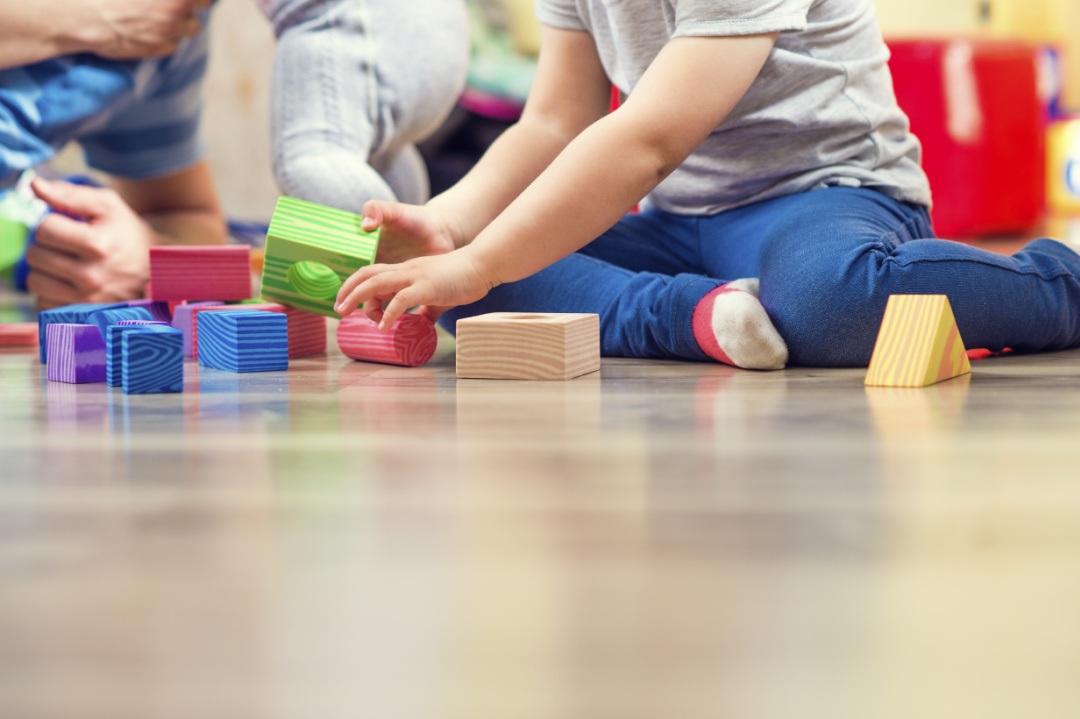Disclaimer: This post is sponsored guest post by Armstrong Flooring.

Playing isn’t just about having fun, it’s one of the most important ways young children learn.
It’s also great for their physical and mental well-being.
By making believe, playing games, crafting or exploring they’re learning about themselves, the world around them and developing valuable life skills.
Setting up a safe play area, both indoors and outdoors, allows them the freedom to play and learn without getting in harm’s way.
Which means you can relax and enjoy yourself too. So how do you create a safe yet fun place for your little ones?
Read on to discover everything you need to know about creating safe spaces for kid’s play.
Choosing the right flooring for active kids
When you have active kids choosing the right flooring is essential.
Moving furniture to build forts, sand from digging expeditions spilt from shoes, glitter, paint and general wear and tear can be hard on some floors.
Cracked flooring, slippery surfaces, and water-damage can all become hazards for small children.
With flooring options like hybrid and luxury vinyl planks you not only get a gorgeous look, but flooring that’s durable, easy to maintain and resistant to scratches and stains.
So you can let the children run amok to their heart’s content, with peace of mind that your floor can handle whatever mischief they may get up to.
Tips for maintaining a safe and clean play environment
Keeping play areas clean not only makes your spaces look tidy, but helps avoid slips and falls.
Children can be busy bees when they’re playing, pulling things out of cupboards, spreading their toys all over the floor, and generally leaving little trails of chaos behind them.
The temptation to start the next fun thing without stopping to tidy up the last is often too great to resist, which is why having a regular cleaning routine is vital.
Get into the habit of doing a daily tidy up together.
Make it fun by putting a favorite song on and challenge your children to see how much they (and you) can put away before the song ends.
You can also add a weekly reset into your routine for a play area deep clean, wiping down surfaces, cleaning the floor, and returning things to where they belong.
Once a month, check over play equipment for wear and tear, and repair or replace anything that requires it.
As your children grow and develop new skills, think about whether your safety measures need to be updated.
Could locks on doors or shelves with breakable objects that were previously out of reach of little hands now be accessible?
Has your child discovered climbing, starting to scale furniture and other objects to new heights?
By regularly updating your play space to reflect your children’s development and interests it’ll always be a safe and engaging space for them to explore.
Safety measures for preventing accidents
The best way to avoid accidents is with good planning, so here’s a few safety measures that you can take to prevent accidents in play areas:
- Anchor heavy or tall furniture such as bookshelves, dressers or cabinets to walls to prevent tipping over.
- Place safety gates at the top and bottom of stairs to prevent falls.
- Use gates to block access to potentially hazardous spaces in kitchens or bathrooms.
- Cover electrical outlets with safety plugs or outlet covers.
- Install bumpers on sharp furniture edges and corners to reduce injury risk.
- Keep cords and blind strings out of reach to avoid children getting caught up in them.
- Store toys in bins or shelves that are easily accessible to prevent children from climbing on furniture.
- Use non-slip mats and make sure their corners are flush with the floor.
- Keep play areas free of clutter and ensure walkways are clear to prevent tripping.
- Regularly check play areas for broken toys, loose parts, or other hazards and fix them straight away.
Kid-friendly furniture and decor tips
Furniture in children’s play areas should be both safe and functional.
When they’re young, many children will explore by mouthing objects and furniture, so it’s best to ensure everything in the play area is made of non-toxic materials.
You might also want to invest in pieces with rounded edges to help prevent injuries.
Multifunctional furniture is another must for children’s spaces. These pieces can adapt to different uses as your children move through different developmental stages.
Think items like cots that can turn into toddler beds then a couch, or soft play modules that can be used as furniture or to build with, unleashing their creativity.
To keep the space safely clutter-free, organising toys in tubs or bins, ensuring everything has a designated place.
Creating zones for different activities
Have you ever noticed that kindergarten rooms are organised into different play stations?
Adopt the same approach in your home play area, creating specific zones for various activities. This might look like:
- Reading corners
- Craft tables
- Active play spaces
It’s also a great way to manage mess and ensure each activity has an area that’s both safe and suitable.
Using a room visualizer can help you see and effectively plan the layout and design of your zones.
Peace of mind through safe play spaces
Creating safe play spaces for your children that pique their curiosity with distinct play zones that are age appropriate can greatly enhance their play (and learning) experience.
By choosing flooring and furniture that is as durable as it is beautiful, taking measures to minimize accidents, and keeping everything clean and well organized everyone can play and relax with complete peace of mind.